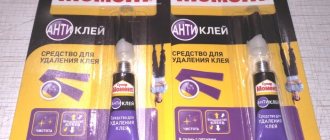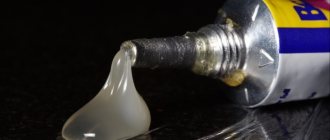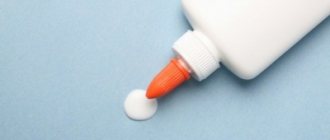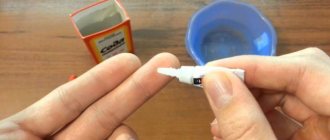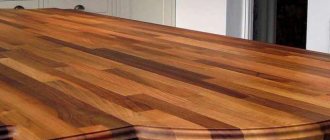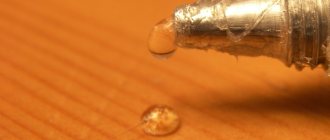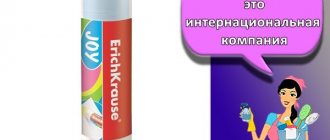Introduction to the topic
Cyanoacrylates firmly glue materials that are homogeneous and heterogeneous in structure, which explains the popularity and versatility of using super glue.
The “second” composition can withstand high tensile loads and forms a transparent layer on the treated surface that has high strength.
Cyanoacrylates began to be widely used at the end of the 20th century, although the substance was invented much earlier. In 1951, the American scientist Harry Coover demonstrated to the world the incredible properties of super glue, and in 1958 the composition went on sale.
Main characteristics of cyanoacrylates:
- Wide operating temperature range from -50 to +125°C.
- Easily withstands loads of 150-250 kg/sq.cm.
- Instant setting, completely dry in 24 hours.
- Firmly fixes products made of metal, wood, glass, ceramics.
- The applied seam has good elasticity and durability.
Super glues are used in various industries and in everyday life. With their help, you can repair shoes in a couple of minutes, glue a loose fragment of a tile, glue together broken dishes or souvenirs. The basis of second glue is cyanoacrylate, but to improve performance characteristics, product manufacturers add modifying additives, plasticizers, stabilizers, activators and retarders.
The main advantage of any brand of super glue is instant fixation of the elements being glued and universal use.
Many domestic and foreign companies are engaged in the production of adhesive products, so the range of products is quite extensive.
On a note! Super glue is produced in compact tubes with a convenient tip, the mass of the product is several grams. In an unsealed package, the substance dries out instantly, so you need to wipe the tip of the tube and screw the cap tightly.
How to dissolve
You need to work with super glue as carefully as possible, excluding the quick-drying composition from getting on neighboring objects, products, or surfaces.
If such a nuisance accidentally occurs, do not worry, you can remove cyanoacrylate residues using various means. You just need to choose a substance to dissolve super glue.
The most effective formulations:
- Special anti-glue. The product is produced for use in construction and repair work. The anti-glue package looks like a tube of cyanoacrylate. The composition contains strong chemicals, so before use you should carefully read the manufacturer's instructions. Some companies produce super glue and a remover for it, which is very convenient.
2. Acetone. Due to the strong specific odor, this glue solvent is best used outdoors or in a well-ventilated area. In order not to spoil the surface to be cleaned, the effect of acetone is checked on an inconspicuous area. What can be removed: glue residues from metal and wooden objects; processing of delicate fabrics is excluded.
3. Nail polish remover. Essentially the same as acetone, but less aggressive due to the lower concentration of the main component. Just in case, it is better to first test the liquid on the surface of the product. It is applied to the glue stain for 15-20 minutes, then cleaned off with the hard side of a foam sponge.
4. White spirit and gasoline. Aggressive liquids that are recommended for use outdoors. Before dissolving Moment glue or other super glue, you need to check the interaction of the product with aggressive substances. White spirit (gasoline) is applied to the glue stain, left for a while, and the remaining cyanoacrylate is removed. The products are suitable for textiles, plastic, metal.
5. Dimexide. Inexpensive pharmaceutical product, sold in the public domain. Its interesting feature is the rapid dissolution of adhesives, including cyanoacrylates. Dimexide can be used to treat soft products, such as textiles. It is suitable for removing super glue residue from the surfaces of tablets, smartphones, laptop monitors and hard materials (glass, plastic, metal).
All solvents contain chemically active components that gradually destroy the structure of the adhesive layer. After some time, the super glue softens, which makes it easy to remove dirt from various materials.
Attention! When using solvents, you need to consider the type of surface being treated. Clothing and textiles made from delicate fabrics may be damaged by chemical components, and plastic may become dull after treatment.
Features of the composition of superglue
Before moving on to the question of how to dissolve glue, it is worth understanding its composition.
The main feature of any super glue is the absence of organic solvents. Thus, they cause minimal harm to the human body and become more effective for fastening metal parts together.
The main component of super glue (about 98%) is cyanoacrylic acid ester (cyanoacrylate). It is this substance that has a high hardening rate and also ensures the reliability, strength and durability of joints.
In addition, the super glue contains the following components:
- plasticizer - makes the adhesive elastic;
- stabilizer - keeps the glue in a liquid state before use and gives it the necessary qualities after hardening;
- thickener - gives the gel consistency of the desired thickness;
- modifier - provides moisture and heat resistance;
- adhesion (adhesion) enhancer - necessary for stronger bonding of surfaces;
- substances that activate hardening (at low humidity) or inhibit the hardening of glue;
- fine metal powder - necessary to improve electrical conductivity.
Manufacturers produce super glue in blisters, tubes, jars, and also in the form of adhesive tapes. They have one thing in common: the packaging is always small in volume. After opening, you must use the entire contents, because... even a slight violation of the tightness turns the glue first into a viscous substance, and then the substance completely hardens and becomes unusable.
You might be interested in reading the article “How to Safely Remove Super Glue from Tables and Wooden Furniture.” Read here...
How to wash
On some materials, super glue residues can be easily removed using traditional methods, which allows you to solve the problem in a matter of minutes. The ingredients for homemade mixtures are always at hand, and preparing the mixture takes little time.
They do not dissolve super glue, but help to wash it off:
- Citric acid – 25 g per liter of water.
- Vinegar diluted with water in a ratio of 1:2.
- Soap solution for soaking clothes.
- Margarine and vegetable oil remove glue from your hands.
Super glue can also be removed mechanically, using a brush or sandpaper. If cyanoacrylate gets on your hands, you can wash them with a cosmetic scrub.
From the skin
When super glue gets on the skin, which often happens when repairing shoes and gluing small fragments together, it forms a thin adhesive film. You can't just wash your fingers with soap.
The following methods are suitable for dissolving glue on the skin of your hands:
- Wipe the stained area with acetone and wash your hands with warm water.
- Use pumice to scrape off the glue. You don't need to rub your hands too much.
- Pour a large spoonful of table salt into your palms and rub.
To prevent such methods of cleaning glue from damaging the skin on your hands, you need to use a cream or lotion after treatment.
Alternatively, you can use a nail file or rub the skin with sandpaper to remove the glue. Rubbing margarine or vegetable oil gives good results, especially for sensitive skin.
On a note! You can use washing powder, which should be mixed with water in a ratio of 1:3 - super glue will be washed off from the skin within 5-20 minutes. You can also use a regular scrub, salt or lemon solution (mix 2 teaspoons of juice or salt with warm water) and rub the area with glue with this solution for a couple of minutes until the glue comes off. Another interesting option for cleansing your hands is regular vodka. It is enough to hold your fingers in it for about fifteen minutes.
From metal
If you need to remove super glue from metal elements, you can use:
- Acetone.
- Ethanol.
- Alcohol.
- White Spirit.
- Solvent "B 646" or similar.
- Undiluted vinegar or concentrated vinegar essence (the higher the percentage, the better).
To completely get rid of dirt, apply solvent or acetone to a cotton pad or thick cotton cloth, apply it to the stained area, and stick tape on top. As a result, an air-tight environment is created, the glue inside will heat up and its remains can be easily removed after removing the tape.
From linoleum
Super glue often ends up on linoleum. To remove it, you should resort to chemical solvents.
To clean the surface, choose “Super Moment Anti-Glue”, “Anti-Glue” or “Contact”. When they are applied to a surface, the glue begins to dissolve and turn into a rubber-like substance that is easily removed.
If you don’t have the time or opportunity to run to the store, gasoline is used to remove glue from linoleum. If the stain is already old, you need to wait a few minutes until the glue begins to dissolve. When working with gasoline, you should follow safety precautions, as the substance is flammable. There should be no children in the room while working. After working with gasoline, the surface is washed with water.
To clean super glue from linoleum, do not use acetone: it can damage the surface.
From plastic
Very often the question arises of how to remove traces of glue from plastic surfaces. The most effective super glue removers, such as acetone and white spirit, can dissolve the plastic or change its color. And abrasive methods using scrubs, salt or ground coffee cause irreparable harm to the appearance of the plastic, scratching it. Therefore, it is best to use Dimexide, which can be purchased at a pharmacy. To remove super glue using this product, you should rub, but do not soak the stain in it, otherwise the plastic itself may also dissolve.
Acetone is not recommended for use on plastic because it can discolor the plastic. We recommend that you try it on some inconspicuous part of the plastic before use. Do not soak plastic elements in acetone!
Ethanol works best on plastic. It does not dissolve plastic or change its color. The disadvantage of this method is that super glue does not dissolve very quickly, you will have to put in a little effort to get a good result.
Plastic does not tolerate temperature changes well, and can also be damaged when using certain chemical solvents, so do not use acetone or gasoline for plastic surfaces.
If the glue on the plastic surface has already dried, you can try to cut it off very carefully.
How to remove super glue from glass?
The easiest way to remove super glue from glass is if the stain is fresh; to do this, just wipe the glass with a rag.
If the glue still has time to dry, then the following compositions are used:
- Cleaner. It is applied to the glass, after a few minutes the glue is removed with a knife.
- White Spirit. It is applied to the glass with a cotton pad, after 15 minutes the softened glue is removed with a stationery knife.
- Vegetable oil. Apply for 1 hour, then remove with a plastic spatula or spatula.
- Liquid soap, dish soap. A little composition is added to the water, the soap solution is applied to the glass and after a while it is washed off with a dish brush.
You can also remove glue from glass using ammonia and dishwashing detergent. To do this, take them in equal proportions and apply the mixture to the stain for 1 hour. After this, the contamination is removed and the glass is wiped with a solution of ammonia in the ratio: 1 tbsp. l alcohol per 0.5 l. water.
Non-aggressive methods of removal
Water
To make it easier to wipe off the glue, you need to soak it. A damp, clean cloth is placed on the surface for a day. Periodically, the rags are moistened with water. After 24 hours, the glue can be easily removed with water.
The method is effective when superglue has not yet ingrained itself into the plastic. Dried stains are removed layer by layer, so cleaning may take several days.
Soap solution
Washing is accelerated by adding liquid, laundry or scented soap to the water. Fresh marks can be easily removed with a soapy cloth. Old stains are softened in the same way as with ordinary water, but a rag soaked in the solution is placed on the contaminated surface for only a few hours. Afterwards, the remaining adhesive mass is removed with a cloth.
Wiper
You can clean the plastic only from fresh stains. Sometimes a double application of glass cleaner is required to remove it.
Alcohol
Due to the rapid evaporation and drying of alcohol, it can only remove the top layer of glue. The product washes away small stains of small thickness.
Vegetable oil
Oil is a softener. It is applied, and after half an hour it is removed along with the glue with clean water or diluted with soap. To remove stubborn oil deposits, use alcohol or acetone.
Instead of oil, you can similarly use Vaseline.
Useful tips
If the area of glue contact is small and it has recently dried, you can use water and soap and soap solutions (detergent, powder, gels), the disadvantage of this method is that the solutions have low efficiency.
If alcohol or solvent is not available, try using a window cleaner that contains alcohol or other volatile elements.
Super glue on the skin completely comes off on its own after 1-3 days, thanks to the secretions of the sebaceous glands of the skin, which “push” it from the surface.
Stores sell products such as Contact cleaner and Anti-Glue remover. Their effectiveness varies depending on the manufacturer. In any case, before using products, make sure that they do not negatively affect your surface.
Use any liquid product with gloves, as aggressive liquid can not only remove the adhesive, but also damage your skin. Be especially careful when working with Dimexide, as it can penetrate even intact skin and cause irritation. Dimexide must be diluted in a ratio of 1:3.
Dried glue can also be removed mechanically - with a blade, knife, or needle. Be careful not to damage the surface.
It is important to follow safety precautions while working. If glue gets into your eye, consult a doctor immediately. You need to take a tube with you: this will make it clearer to the doctor how to treat the eye.
The tube is not directed towards yourself so that the substance does not accidentally get on the skin and face. The composition contains toxic substances, so work is carried out in well-ventilated areas.
If not all the glue is used, you should not roll up the tube: there is a chance that it will crack at the bend and the substance will spill out.
If super glue gets into places that are difficult to reach, for example, in a lock, then vinegar essence will help. Using a syringe, you need to pour it inside the lock, wait a little and clean it with a needle or toothpick. Anti-glue or another solvent will also help to deal with such contaminants.
How to remove super glue? (2 videos)
Removing super glue from different surfaces (15 photos)
In case of contact with metal
The method is the same, only the solvents themselves differ. To remove glue from metal surfaces you can use:
- Acetone.
- Alcohol.
- Undiluted vinegar.
- White Spirit.
Algorithm of actions:
- Apply the solvent to cotton wool or thick fabric.
- Apply to the stain.
- Seal with tape.
Thus, we create a “greenhouse”; the glue will heat up and can be easily removed from the surface.

